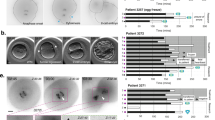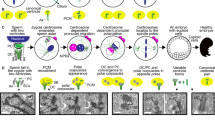Summary
The concept and role of endomitosis is reevaluated in the light of observations on three organisms. Endomitosis which morphologically agrees with Geitler's (1939) classical definition is compared in tapetal cells of the liliaceous plant Eremurus, in the septal cells of the testicular follicles of the grasshopper Melanoplus, and in human cells from normal and molar trophoblasts and cervical cancer. These observations, together with those of Kidnadze and Istomina (1980), show that functionally at least two fundamentally different types of endomitosis exist, although morphologically the stages resemble each other in the three organisms. In the first type, exemplified by Eremurus, each endomitosis leads to a chromosome constitution which represents one level higher ploidy, a course that has been assumed to be characteristic of endomitosis in general. The second type, observed in its most characteristic form in the grasshopper, seems to be stationary: no DNA synthesis occurs, but an intensive RNA synthesis takes place. Presumably such cells have reached a final state in their development and are specialized in manufacturing one or more gene products. Endomitosis in normal placenta comes near this type, although DNA synthesis takes place in occasional cells. However, similar endomitotic nuclei in the hydatiform moles are in the process of DNA synthesis. When endomitosis is analyzed in different organisms and tissues, the observation that this process is not one entity should be kept in mind.
Similar content being viewed by others
References
Beermann W (1962) Riesenchromosomen. Protoplasmatologia 6D: 1–161
D'Amato F (1952) Polyploidy in the differentiation and function of tissues and cells in plants. Caryologia 4:311–358
D'Amato F (1954) A brief discussion on “endomitosis”. Caryologia 6:341–344
D'Amato F (1964) Endopolyploidy as a factor in plant tissue development. Caryologia 17:41–52
Geitler L (1939) Die Entstehung der polyploiden Somakerne der Heteropteren durch Chromosomenteilung ohne Kernteilung Chromosoma 1:1–22
Geitler L (1953) Endomitose und endomitotische Polyploidisierung. Protoplasmatologia 6 C:1–89
Heitz E (1953) Über intraindividuale Polyploidie. Arch Julius Klaus-Stiftung 28:260–271
Ilgren EB (1981) The initiation and control of trophoblastic growth in the mouse: Binucleation and polyploidy. Placenta2:317–332
Kiknadze H, Istomina AG (1980) Endomitosis in grasshoppers. I. Nuclear morphology and synthesis of DNA and RNA in the endopolyploid cells of the inner parietal layer of the testicular follicle. Eur J Cell Biol 21:122–133
Levan A, Hauschka TS (1953) Endomitotic reduplication mechanisms in ascites tumors of the mouse. J Natl Cancer Inst 14:1–43
Nagl W (1978) Endopolyploidy and polyteny in differentiation and evolution. North-Holland Publ Co Amsterdam
Nagl W (1982) Cell growth and nuclear DNA increase by endoreduplication and differential DNA replication. In: Nicolini C (ed) Cell growth. Plenum Publ Corp, New York, pp 619–651
Oksala T (1939) Über Tetraploidie der Binde- und Fettgewebe bei den Odonaten. Hereditas 25:132–144
Oksala T, Therman E (1974) Mitotic abnormalities and cancer. In: German J (ed) Chromosomes and cancer John Wiley and Sons, New York, pp 240–263
Oksala T, Therman E (1977) Endomitosis in tapetal cells of Eremurus (Liliaceae). Am J Botany 64:866–872
Sarto GE, Stubblefield PA, Therman E (1982) Endomitosis in human trophoblast. Hum Genet (in press)
Therman E (1951) The effect of indole-3-acetic acid on resting plant nuclei. I. Allium cepa. Ann Acad Sci Fenn A, IV 16:5–40
Therman E, Sarto GE, Buchler DA (1982) The structure and origin of giant nuclei in human cancer cells. Cancer Genet Cytogenet (in press)
Timonen S, Therman E (1956) Endomitotic nuclear growth in a human cervical carcinoma. Ann Chir Gyn Fenn 45:237–244
Tschermak-Woess E (1956) Karyologische Pflanzenanatomie. Protoplasma 46:798–834
Tschermak-Woess E (1963) Strukturtypen der Ruhekerne von Pflanzen und Tieren. Protoplasmatologia 5:1–158
Tschermak-Woess E (1971) Endomitose. In: Handbuch der Allgemeinen Pathologie 2. Springer, Berlin, pp 569–625
Zybina EV, Kudryavtseva MV, Kudryavtsev BN (1975) Polyploidization and endomitosis in giant cells of rabbit trophoblast. Cell Tissue Res 160:525–537
Author information
Authors and Affiliations
Rights and permissions
About this article
Cite this article
Therman, E., Sarto, G.E. & Stubblefield, P.A. Endomitosis: A reappraisal. Hum Genet 63, 13–18 (1983). https://doi.org/10.1007/BF00285390
Received:
Revised:
Published:
Issue Date:
DOI: https://doi.org/10.1007/BF00285390




